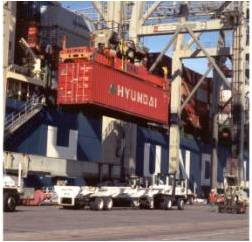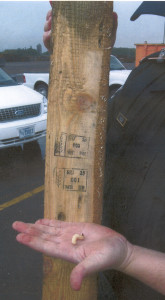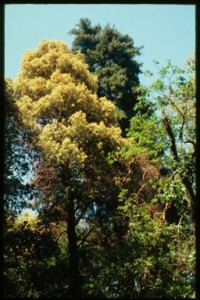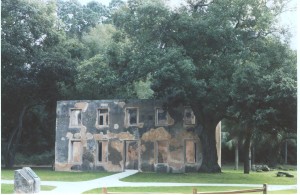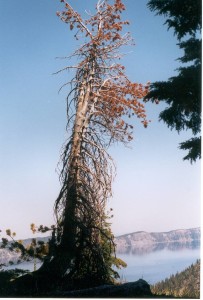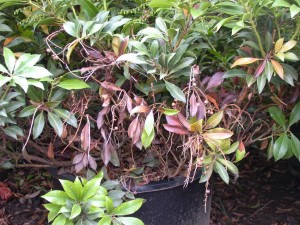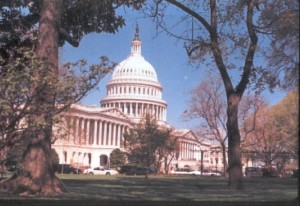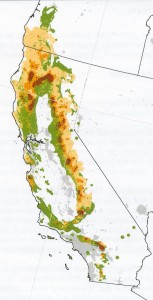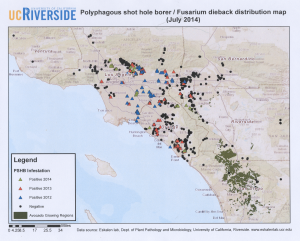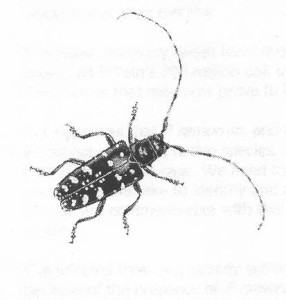As noted in my blog of July 15, damaging pests continue to enter the country in wood packaging. The most comprehensive study indicates that tree-killing pests are found in an estimated 13,000 containers entering the country each year – or 35 per day.
These pests are present despite requirements adopted 9 or more years ago that wood packaging be treated.
Types of cargo packaged in wood are inspected by agricultural specialists within the Bureau of Customs and Border Protection , a division of the Department of Homeland Security. CBP agricultural specialists work at 167 sea, air and land ports of entry. See an article about CBP efforts to curb introductions of tree-killing pests posted at http://www.cbp.gov/frontline/2014/12/frontline-december-forest-prime-evil.
![CBP agriculture specialists in Laredo, Texas, examine a wooden pallet for signs of insect infestation. [Note presence of an apparent ISPM stamp on the side of the pallet] Photo by Rick Pauza](http://nivemnic.us/wp-content/uploads/2015/09/CPB-SWPM-inspection-300x200.jpg)
According to the CBP in the above article, the types of commodities imported that have the highest rates of SWPM-related pest interceptions are metal and stone products (including tile), machinery (such as automobile parts and farm equipment), electronics, bulk food shipments and finished wood articles.
These imports have a long-standing record of pest presence – as described in Chapter 4 of my lengthy report on tree-killing pests.
According to the CBP , 48% of the wood packaging entering the country that does not comply with the treatment requirements comes from Mexico. Mexican maquiladoras are factories that import material and equipment duty-free, then assemble a wide range of products – auto parts, apparel, electronics, furniture, and appliances. Mexico’s 3,000 maquiladoras account for half of Mexico’s exports.
China has the second worst record.
Of course, we import lots of stuff from both countries! However, the China situation is particularly disturbing because the U.S. has required that wood packaging from China be treated since the beginning of 1999 – 16 years!
The ports receiving highest numbers of shipments with non-compliant wood packaging materials have consistently been those along the U.S.-Mexico border, especially in Texas: Laredo, Pharr, more recently Brownsville & Houston. Other ports receiving high volumes of non-compliant wood packaging include Blaine, Washington; Long Beach, California; and Romulus, Michigan.
USDA APHIS and CBP have cooperated in a program under which insect larvae found in wood packaging are identified as to species. In recent years, they have studied larvae detected in wood packaging from eight ports – Long Beach, Seattle; 2 ports in Florida; and three cities on the Texas-Mexico border. (Remember, there are 167 ports of entry across the country, so this sample represented 5% of all ports.) Found at these ports were an unreported total of insects, including 116 individuals in the same family as Asian longhorned beetle (Cerambycids). Forty-three were from China (including 5 ALB), 20 from Russia, and seven from Mexico (Philip Berger, APHIS, at the annual meeting of the Continental Dialogue on Non-Native Forest Insects and Diseases, November 2014)
Most familiar – and frightening! – examples of pests introduced via wood packaging include Asian longhorned beetle, emerald ash borer, redbay ambrosia beetle and its accompanying fungus, and possibly polyphagous shot hole borer and its accompanying fungus – all described here.
The prospect of receiving additional insects from Asia scares everyone. What if a new pest is as bad as the four we already have? The emerald ash borer has already caused the removal of an estimated 50 million trees and continues to spread to ash trees – and now white fringe trees – throughout America east of the Great Plains. Laurel wilt disease (transmitted by the redbay ambrosia beetle) is rapidly eradicating redbay trees in the southeast, including in Everglades National Park – one of the icons of the American conservation movement. The Asian longhorned beetle has already caused removal of more than 124,000 trees from our cities, suburbs, and nearby woodlands – at a cost to federal taxpayers of more than $500 million. If it escapes eradication programs, it threatens trees in 10% of America’s forests. The polyphagous shot hole borer threatens numerous tree species that, collectively, make up more than half the trees planted in urbanareas in Southern California.
While no one denies the threat from insects native to Asia, we should not be complacent about insects from Mexico. Although we are neighbors, our forests are separated by deserts – allowing insects to evolve there to which our trees are vulnerable. Three wood-boring beetles native to Mexico and possibly some U.S. border states are already causing havoc to U.S. trees – goldspotted oak borer, soapberry borer, and walnut twig beetle and its accompanying fungus (all described here). The first two were introduced to vulnerable forests through movement of firewood, not wood packaging. The third – the walnut twig beetle – might be native to California, although thousand cankers disease is killing native California walnuts throughout the state so something is different than it used to be.
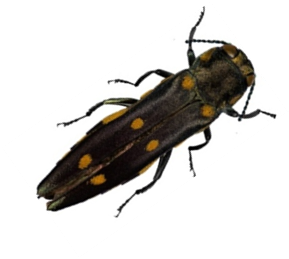
When Customs officials detect wood packaging that does not comply with ISPM #15 (“noncompliance” means one of three things: the wood does not bear the ISPM #15 stamp; or the stamp appears to be fraudulent; or signs of pests are detected), that wood must be re-exported immediately, usually with the associated commodity. If any insects present pose an immediate risk of introduction, e.g., if adults are emerging, the shipment might need to be fumigated before re-export.
Re-exported shipments – and any treatments – cause importers to lose income and face costly delays. Still, the continuing presence of non-compliant wood packaging indicates that these inconveniences are insufficient to prompt importers to take all precautions possible to ensure that packaging used by their suppliers and brokers comply with the requirements.
Why don’t importers use alternative packaging made from plastic, steel, or composites that would not harbor tree-killing insects? Plastic pallets also weigh much less than wooden ones, so transport costs are reduced. Customs has pointed out the advantages. … Still, packaging material made from wood is comparatively plentiful, cheap, easy to repair, biodegradable. So it continues to dominate the market.
What steps can be taken by the U.S. government and importers to minimize the presence of insects in packaging?
• U.S. policy allows an importer to be caught 5 times in 1 year with wood packaging that does not comply with the regulatory requirements. Requirements adopted a decade or more ago should be enforced strictly! The Bureau of Customs and Border Protection and USDA APHIS should instead penalize all importers whose wood packaging does not comply with the regulations.
• The Bureau of Customs and Border Protection should incorporate the wood packaging requirements into its “Customs-Trade Partnership Against Terrorism” (C-TPAT) program .
• USDA APHIS should re-examine the economic pros and cons of requiring importers to switch to packaging made from materials other than wooden boards. The new review should incorporate the high economic and ecological costs imposed by insects introduced via the wood packaging pathway.
• The President’s Office of Management and Budget should allow APHIS to finalize regulations – proposed in 5 years ago! – that would apply the same treatment requirements to wood packaging used in trade between the US and Canada. (Canada has been ready to adopt this measure for several years.)
• Importer’ contracts with suppliers routinely specify penalties for delivery delays; the contracts should be amended to add penalties for noncompliant wood packaging.
• A decade ago, USDA APHIS funded research which developed an ingenious method for detecting mobile pests inside a container. It was an LED light attached to a sticky trap. Placed inside a container, the light attracted snails, insects and possibly other living organisms. The whole mechanism was attached to a mailing container that could be pre-addressed for sending to a lab that could identify the pests. Why was this tool never implemented?
Posted by Faith Campbell
